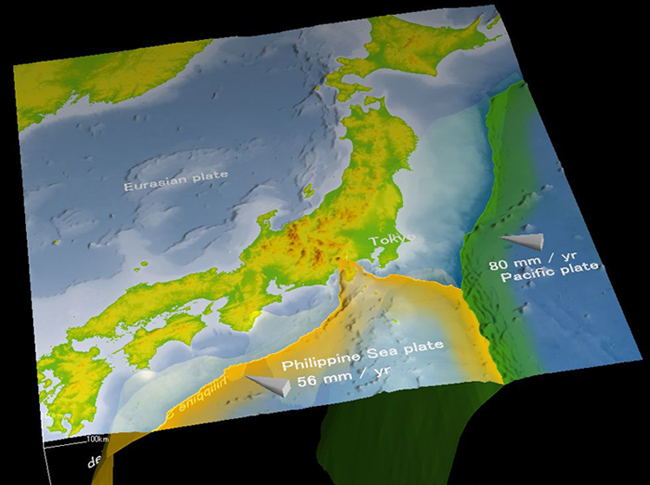3D model of Tectonic Plates’ disposition around Japan.
You can see that Pacific plate and Philippine Sea plate are sinking under the Japanese Archipelago.
This data was used in TV program BURATAMORI by NHK.(October 14 2017)
Description
Most part of the Japanese Archipelago are on Eurasian plate*.
Philippine Sea plate is sinking under Eurasian plate. Sunk part (slab) is quite distorted.
Izu peninsula is on Philippine Sea plate, and colliding Japanese Archipelago around Mt. Fuji.
Philippine Sea plate is moving to northwest by about 5.6 cm per year.
Pacific plate is sinking under both Eurasian plate and Philippine Sea plate. It is moving to northwest by 8.0 cm per year.
*) Adopt this term despite of various theories.
Download
TectonicPlatesAroundJapanE.zip
(Please unzip the file)
- Needs freeware Molcer over ver.1.27.
- If you use this data, show source as “https://white-rabbit.jp/contents/TectonicPlatesAroundJapan/indexE.html” and link to this page.

Screen shot. Emphasized height by four times.
Green:Upper Surface of Pacific Plate
Orange:Upper Surface of Philippine Sea plate
Movie.
Also available for scaling, viewing section by arbitrary clipping plane, and so on.
References
Referred following papers or documents.
- Plate Figure (numeric data from Meteorologist Fuyuki Hirose’s HP)
Kita, S., T. Okada, A. Hasegawa, J. Nakajima, and T. Matsuzawa (2010), Anomalous deepening of a seismic belt in the upper-plane of the double seismic zone in the Pacific slab beneath the Hokkaido corner: Possible evidence for thermal shielding caused by subducted forearc crust materials, Earth Planet. Science Lett., 290, 415-426.
J. Nakajima and A. Hasegawa (2006), Anomalous low-velocity zone and linear alignment of seismicity along it in the subducted Pacific slab beneath Kanto, Japan: Reactivation of subducted fracture zone?, Geophys. Res. Lett., 33, L16309, doi: 10.1029/2006GL026773.
J. Nakajima, F. Hirose, and A. Hasegawa (2009), Seismotectonics beneath the Tokyo metropolitan area, Japan: Effect of slab-slab contact and overlap on seismicity, J. Geophys. Res., 114, B08309, doi:10.1029/2008JB006101
F. Hirose, J. Nakajima, and A. Hasegawa (2008), Three-dimensional seismic velocity structure and configuration of the Philippine Sea slab in Southwestern Japan estimated by double-difference tomography, J. Geophys. Res., 113, B09315, doi:10.1029/2007JB005274.
Hirose F, Nakajima J, Hasegawa A (2007) Three-dimensional velocity structure and configuration of the Philippine Sea slab beneath SouthWestern Japan, estimated by double-difference tomography. Zisin Ser 2(60):1–20 (in Japanese with English abstract)
Hirose F, Nakajima J, Hasegawa A (2008) Three-dimensional velocity structure and configuration of the Philippine Sea slab beneath Kanto District, Central Japan, estimated by double-difference tomography. Zisin Ser 2(60):123–138 (in Japanese with English abstract)
J. Nakajima and A. Hasegawa (2007), Subduction of the Philippine Sea plate beneath Southwestern Japan: Slab geometry and its relationship to arc magmatism, J. Geophys. Res., 112, B08306, doi:10.1029/2006JB004770.
Baba, T., Y. Tanioka, P. R. Cummins, and K. Uhira (2002), The slip distribution of the 1946 Nankai earthquake estimated from tsunami inversion using a new plate model, Phys. Earth Planet. Inter., 132, 59-73.
Uchida, N., J. Nakajima, A. Hasegawa, and T. Matsuzawa (2009), What controls interplate coupling?: Evidence for abrupt change in coupling across a border between two overlying plates in the NE Japan subduction zone, Earth Planet. Sci. Lett., 283, 111-121. - Plate sinking direction and speed
Wei, D., and T. Seno (1998), Determination of the Amurian plate motion, in “Mantle dynamics and plate interactions in East Asia”, Geodynamics. Series, 27, ed. by M. F. J. Flower, S. L. Chung, C. H. Lo, and T. Y. Lee, pp. 337-346, AGU, Washington D. C. - Attitude / Water depth
Becker, J. J., D. T. Sandwell, W. H. F. Smith, J. Braud, B. Binder, J. Depner, D. Fabre, J. Factor, S. Ingalls, S-H. Kim, R. Ladner, K. Marks, S. Nelson, A. Pharaoh, R. Trimmer, J. Von Rosenberg, G. Wallace, P. Weatherall. (2009), Global Bathymetry and Elevation Data at 30 Arc Seconds Resolution: SRTM30_PLUS, Marine Geodesy, 32:4, 355-371.
Sandwell, D. T., and W. H. F. Smith (2009), Global marine gravity from retracked Geosat and ERS-1 altimetry: Ridge Segmentation versus spreading rate, J. Geophys. Res., 114, B01411, doi:10.1029/2008JB006008.
See further: Mining Museum of Akita University
Update history
April 24 2017 Separated from Japanese version.
April 26 2016 Replaced by light version.
November 20 2011 Released.
Molcer Plus--3D image visualization and processing software
Reconstruct 3D models from sectional image sequences produced by X-ray CT or MRI. Easy to see surface / section / internal structure of data. It also implements ultrafast arithmetic operation by GPGPU.
Various measuring / analyzing methods are available. As well as processing / trimming / filtering / polygon reduction. Useful for 3D printing.
